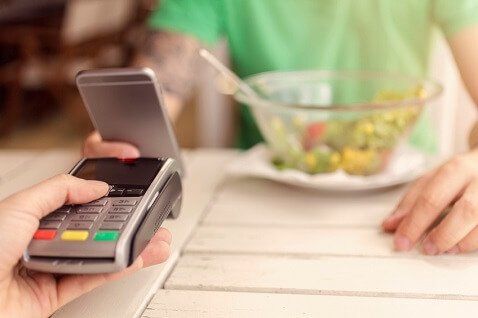We will first focus on how mobile wallets work. You begin by installing a digital wallet app and supplying your payment, shipping, and other key information. The app includes security and encryption features and has a chip that enables a technology called near-field communication (NFC), which communicates with receivers in stores.
The retailer reads the information from your smartphone, taps into your bank account (or other sources, such as a PayPal account or a credit or debit card), verifies your identity, and the purchase goes through, sending an automatic receipt to your account.
In addition to the advantages of speed and convenience, many people like the idea of downsizing their wallets by reducing or eliminating the number of cards they need to carry. Also, the information is backed-up and secured electronically, so replacement is easier in case of theft or loss. Plus, digital wallets' encryption technology is more secure than swiping physical cards through magnetic readers.
No single app dominates the market, so the “best” one will depend on what features are most attractive to you. Here are a few examples of the most widely-used digital wallet apps available today.
1) PayPal
PayPal offers a digital wallet app for both iPhone and Android that lets users make purchases using their PayPal accounts. It also connects to another bank account and allows person-to-person payments, which is when money is sent between PayPal accounts. Other features include a simple checkout process, the ability to track coupons and special deals, and the fact that it works on almost every type of phone. If you do not already have a PayPal account, you will need to open one; otherwise, it requires no complicated setup or additional hardware.
2) Samsung Wallet
Previously known as SamsungPay, Samsung Wallet is for Samsung smartphones. It was one of the earliest adopted digital wallet apps due to its compatibility with most magnetic stripe terminals, allowing users to make payments at almost any retailer. This ease of use and the popularity of Android phones makes it an attractive option for some people. Some advanced Samsung smartphones even allow you to authenticate transactions through fingertip sensors. It is allied with many major banks and credit card companies.
3) Venmo
Venmo is a digital wallet that primarily allows users to share payments with friends and family. The platform, which is owned by PayPal, is popular among younger users who use it to pay each other for things like shared meals, rent, and other expenses. The app also has a social aspect, allowing users to share their transactions with friends and see what others are paying for. This social aspect has made Venmo popular among users who want to keep track of their spending and share their experiences with others.
4) ApplePay
Like Samsung Wallet, ApplePay is a proprietary system (it only applies to Apple products) that lets you make credit and debit card payments at participating retailers. It is allied with an extensive list of financial institutions, credit card companies, and major retail locations. Payments can be approved by your phone, fingerprint, FaceID, or Apple Watch. It also works on mobile commerce sites and apps compatible with Apple and allows easy upgrades when you change devices. It recently added the ability to access retail loyalty cards, and for Apple users, it is an attractive and versatile option that’s been enthusiastically adopted.
5) Google Pay
Google Pay, previously known as Google Wallet or Android Pay, is compatible with both Android and iPhone smartphones. It uses the same “tap and pay” function as all the other digital wallets on this list and enjoys acceptance at millions of locations. Users can store credit, debit, gift cards, and loyalty cards and purchase goods through their smartphone, tablet, or desktop computer. Since its release over a decade ago, Google Pay has worked through some early challenges with retail compatibility. Still, the growing availability of ecommerce and point-of-sale technology has mostly resolved them, and it is likely only to keep expanding.
6) Zelle
Zelle is a digital payment platform that allows users to quickly and easily send and receive money from others. The platform, which is owned by a consortium of major banks, is designed to be a fast and convenient way for users to send money to each other without having to use cash or checks. Zelle is available through a variety of different banks and financial institutions, recently including TDECU. In order to use Zelle, users must first enroll with the service and link their bank account or credit card. Once enrolled, they can then use the app or website to send and receive money from others who are also enrolled with Zelle.
The Bottom Line
Mobile wallet apps are not just for “early adopters” anymore. Market researchers expect to see a huge increase in mobile payment transactions in the coming year. With both rapidly changing attitudes and technological advances, you might want to look into whether a mobile wallet is a good choice for you. Learn about all of TDECU's mobile wallet options here.
This blog was initially posted in 2016 and updated in 2023.
